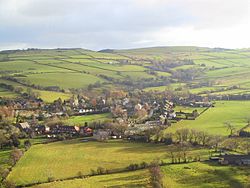Kettleshulme
| Kettleshulme | |
| Cheshire | |
|---|---|
 Kettleshulme seen from Reed Hill | |
| Location | |
| Grid reference: | SJ987797 |
| Location: | 53°18’50"N, 2°1’5"W |
| Data | |
| Population: | 353 (2001[1]) |
| Post town: | High Peak |
| Postcode: | SK23 |
| Dialling code: | 01663 |
| Local Government | |
| Council: | Cheshire East |
| Parliamentary constituency: |
Macclesfield |
Kettleshulme is a village and civil parish in Cheshire, close to the border with Derbyshire. The village is situated on the B5470 road from Whaley Bridge to Macclesfield in the valley of the Todd Brook, a tributary of the River Goyt. The name is from the Old Norse, meaning Ketil's island or Ketil's watermeadow)[2] In 2001, it had a population of 353.[1]
Contents
Geology and climate
Kettleshulme is on the boundary of the Carboniferous limestone of Derbyshire with the Cheshire shale and gritstone. The original settlement mainly consisted of a mixture of limestone and sandstone buildings, including the old church, built in the 19th century out of limestone quarried near Buxton, seven miles away. At 1,000 ft above sea level, Kettleshulme has a relatively elevated position making the weather cold at times but its location and climate make the land suitable for farming. The nearest weather station in Buxton recorded that the area has a mean temperature on average since 1969 up to the present day of 7.8.C and average rainfall per year of 50.6 inches (1,286.0 mm).
Transport and accessibility
The village is in the Pennines, 13 miles from the centre of Manchester, making it popular with commuters. A bus service from Disley passes through Kettleshulme to Macclesfield. The nearest railway station is Whaley Bridge on the Manchester–Buxton line.
Economy and tourism
Kettleshulme was once also a centre for the manufacture of candle-wick material but this ceased in 1937. The old abandoned mill (Lumbhole Mill 1797, rebuilt 1823[3]) still exists but is not in use. It is a Grade-II* listed building, described by English Heritage as "the last example of a mill where water-powered and steam machinery were used together and survive intact".[4] Kettleshulme was the home of 19th-century record-breaker Amos Broadhurst, whose beard grew to a length of seven feet.[5]
The area around Kettleshulme is popular with walkers. To the north are the Bowstones, an early Christian stone sculpture,[6] and nearby Lyme Park. From the Bowstones, it is possible on a clear day to see up to thirty miles in all directions, including, to the west, the Lovell Telescope at Jodrell Bank, at one time the world's largest radio telescope, to the north-west, the city of Manchester and its airport and to the east, the rest of the High Peak including Kinder Scout, the Derbyshire's highest point, and Windgather Rocks.
References
- ↑ 1.0 1.1 Census 2001
- ↑ "Kettleshulme". Key To English Place Names. English Place Name Society. http://kepn.nottingham.ac.uk/map/place/Cheshire/Kettleshulme. Retrieved 9 May 2012.
- ↑ Calladine, Anthony; Fricker, Jean (1993). East Cheshire Textile Mills. London: Royal Commission on Historical Monuments of England. p. 63,64,65. ISBN 1-873592-13-2.
- ↑ National Heritage List 1138938: Grove Mill (Grade II* listing)
- ↑ "Kettleshulme". Peak District Towns and Villages. Cressbrook Multimedia. http://www.cressbrook.co.uk/towns/kettleshulme.php. Retrieved 26 December 2014.
- ↑ "Bowstones". The Megalithic Portal. 7 October 2004. http://www.megalithic.co.uk/article.php?sid=6916. Retrieved 26 December 2014.
Outside links
| ("Wikimedia Commons" has material about Kettleshulme) |